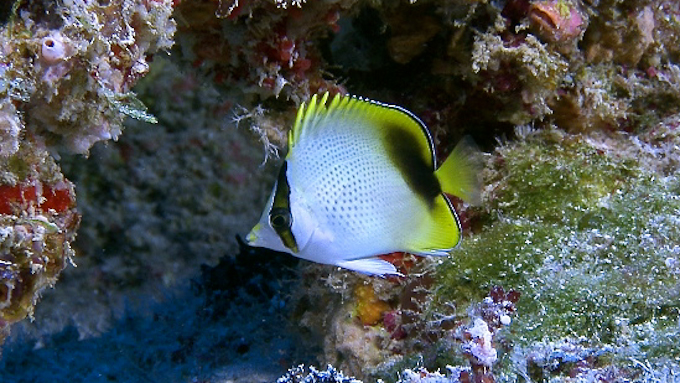
Roaps butterflyfishes can form hybrids with other unrelated members of the butterflyfish group although very rarely, to form inter-subgeneric hybrids. Fishes and other animals generally hybridize with other species that are highly similar, usually in the same genus, or within the same complex. For example, the dwarf angels within the “flavissima complex” and “loricula complex” all readily hybridize to form the assorted lemonpeel hybrids and rusty-flame hybrids we’ve come to know and love respectively.
Ever so rarely do we chance upon hybrids between un-related species in different complexes, or in totally different genera. The hybrids between C. potteri x C. fisheri and C. multicolor x C. ferrugata are examples of hybrids that probably arise from accidental mixing of gametes in the wild. Keep reading for more amazing pictures of hybrid fish.

Although still labelled under the genus Chaetodon, the Roaps butterflyfishes are different enough to be classified as a subgenus comprising of five member species. Hybrid butterflyfish within the Roaps genus are common in areas where the range of certain species overlap. In some places like the Marshall islands and Tawara, Micronesia, hybrids between C. tinkeri, C. burgessi and C. flavocoronatus can be found, with varying degrees of characteristics from each parent species. The only Indian Ocean member of this complex, C. mitratus, is the most different in terms of coloration and has not formed any known hybrids so far.


While it is very common for the Roaps butterflyfishes to form hybrids amongst themselves, it is very rare for them to form hybrids with other butterflyfish outside the subgenus Roaps, and any resulting lovechild from Inter Subgeneric hybridization are likely due to accidental fertilization.
The picture headlining this article shows one example between C. tinkeri and C. miliaris. C. tinkeri can also hybridize with C. quadrimaculatus as seen above. Hybrids between non-closely related species are gorgeous and rare, and the resulting patterns are often unpredictable and spectacular. Who knows what other accidental hybrids may arise in the wild. Here at ReefBuilders, we’re obsessed with the minutiae for natural phenomenon of reef aquarium fish. What else could be more diverse than hybrid phenotype and genotype? Scratch that. Intergeneric and sub-intergeneric hybridization is about as exciting as hybridization gets. Since we’re on the topic of hybrids, below is a small sampling of some very cool hybrids. Not all are intergeneric hybrids, but all are certainly stunning in their own right.

Starting from the first image going clockwise : (C. ferrugata x C. loricula) x C. bispinosa, P. imperator x P. semicirculatus, P. imperator x P. chrysurus, C. potteri x C. loricula, C. lunula x wiebeli/collare?, H. ciliaris x H. tricolor, C. potteri x C. fisheri and C. ferrugata x C. bispinosa.



